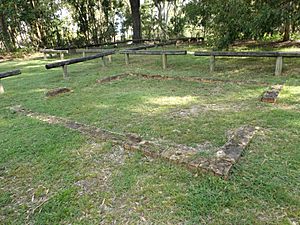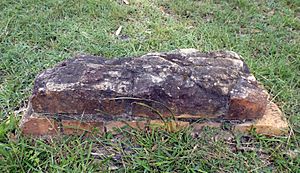Ormiston Fellmongery facts for kids
Quick facts for kids Ormiston Fellmongery |
|
|---|---|

Foundation remnants, 2015
|
|
| Location | Sturgeon Street, Ormiston, City of Redland, Queensland, Australia |
| Official name: Ormiston Fellmongery, Fellmonger Park | |
| Type | archaeological |
| Designated | 18 September 2009 |
| Reference no. | 645606 |
| Significant period | 1850s-1860s, 1890s-1920s (historical use) |
| Significant components | building foundations/ruins |
| Lua error in Module:Location_map at line 420: attempt to index field 'wikibase' (a nil value). | |
The Ormiston Fellmongery is a special archaeological site in Ormiston, Australia. It's where an old factory used to be. This factory was called a fellmongery. A fellmongery was a place where sheepskins were processed to remove the wool. The wool was then cleaned, and the skins were turned into leather. This site is also known as Fellmonger Park. It's listed on the Queensland Heritage Register because it's an important part of Queensland's history.
Contents
History of the Fellmongery
A fellmongery was first built here in 1853 by a man named Thomas Blacket Stephens. It operated for about 10 years. Later, in 1894, another fellmongery started on the same spot. This one was run by Thomas Alford and kept going until the early 1920s. After that, the land was used for farming. In the 1970s, the local council turned it into a park.
Wool Processing in Early Queensland
In the early days, Brisbane and its port were very important for wool. Wool was a big business! Farmers had many sheep, and their wool needed to be processed. At first, sheep were just washed. But by the late 1840s, a new method called wool scouring became popular. This was a way to clean the wool after it was cut from the sheep.
Around the 1850s, fellmongering also became common. This was different from wool scouring. Fellmongering focused on the sheepskins themselves. Workers would remove the wool from the skins, then wash and dry the wool. The skins would then be prepared to be made into leather.
These types of factories, like wool scours and fellmongeries, were often built near creeks. This was because they needed a lot of clean, fresh water for washing the wool and skins. They were also sometimes located near tanneries (where leather was made) and slaughterhouses.
The First Fellmongery: Thomas Blacket Stephens
The Ormiston area, which was once part of Cleveland, was settled early. In 1853, Thomas Blacket Stephens set up his fellmongery here. He hoped to use Cleveland Point as a port for shipping wool. Stephens was an important person in early Queensland. He owned a newspaper and later became a politician.
Stephens moved his business in the early 1860s. It's not clear exactly when his fellmongery at Ormiston stopped working. It might have continued for a few more years under another manager.
The Second Fellmongery: Thomas Alford
About 30 years later, in 1894, the site was used again for a fellmongery. Thomas Alford got permission to build a new wool scouring and fellmongering factory. He built it on a small part of Stephens' original land.
Before coming to Ormiston, Alford had trouble getting permission to build a fellmongery in another area called Bulimba. The people there didn't want a "noisy and smelly" business nearby. But the people of Cleveland welcomed Alford. They knew his factory would bring jobs and money to their town.
Construction of Alford's factory started in August 1894. It was a big project! They brought building materials by train and horse-drawn carts. The factory was expected to take six weeks to build. It included many different parts:
- A large wool shed (40 by 18 feet) with bins for wool, sorting tables, and a wool press.
- Soaks where skins were prepared.
- A sweathouse for loosening wool from skins.
- Sorting sheds for organizing the wool.
- An engine shed with an engine, pump, and washing machine.
- A drying shed for drying wool when the weather was bad.
Mr. T. Sefton, an experienced worker, supervised the factory. Alford also stayed very involved. In 1901, Alford built a dam across Hilliards Creek. This helped him control the water supply, which was vital for his business.
The fellmongery, which also included a wool scour and a slaughteryard, operated until the early 1920s. Later, the land was sold and eventually bought by the Redland Shire Council. Today, it's Fellmonger Park.
What the Site Looks Like Today
The Ormiston Fellmongery site is now part of Fellmonger Park. The park has grassy areas and some small hills with trees. The land slopes down towards Hilliards Creek, and parts of it can flood when it rains a lot. You can see different kinds of trees and plants in the park, including gum trees and tea-trees along the creek.
The main remains of the fellmongery are surrounded by low wooden fences. There are two fenced areas:
- The first area has brick foundations. These foundations are about 5 meters by 4 meters and are two bricks high above the ground. You can see that the bricks are laid in a special pattern called English Bond. One brick even has "Campbells Redbank" stamped on it. These foundations are on the side of a small hill, about 15 meters from the creek.
- The second fenced area is next to the first. It looks like a grassy area, but if you dig a little, you can find bricks and brick pieces about 5 centimeters below the surface. This area is at the top of the small hill.
The rest of the hill is covered with leaves and mulch, with more trees. It's likely that there are more hidden historical remains under the ground in these areas.
There's also an old causeway across Hilliards Creek. A causeway is a raised road or path over wet ground or water. This one is now part of a modern bike and walking track. The lower parts of the causeway are made of rough stone and rubble, which suggests it's very old. Concrete and bitumen have been added on top of the stone over the years. This causeway might have been used by the fellmongery to access the railway station.
Why It's a Heritage Site
The Ormiston Fellmongery was added to the Queensland Heritage Register in 2009. This means it's considered a very important historical place.
Showing Queensland's Past
The remains of the fellmongery help us understand Queensland's history. They show us how important the wool industry was and how wool was processed. It's rare to find physical evidence of wool scouring, fellmongering, and tanning today. Even though these businesses were common in and around Brisbane, the Ormiston Fellmongery is one of the only surviving examples in the area.
Learning from the Past
This site is special because it had two different fellmongeries operating at the same spot, decades apart. This means archaeologists can study the remains from both periods (1850s-1860s and 1894-1920s). This could give us important information about how fellmongering changed over time in Queensland.
The visible brick foundations and the hidden brick deposits are likely from the second period of operation (1894-1920s). Studying these remains can tell us a lot about how the factory was organized. It might also show us where materials came from, giving clues about trade in the region.
There might also be hidden archaeological remains from the very first fellmongery, built by Thomas Blacket Stephens. He was a very important person in early Queensland. He owned a newspaper and was involved in politics. Studying his fellmongery could give us insights into his work and how his ideas were reflected in his business practices.
The Old Causeway
The old causeway across Hilliards Creek is also important. It's very close to the fellmongery and was probably used to transport goods to and from the railway station before 1895. Studying the causeway could teach us about early road-building techniques and help us figure out exactly when it was built.
Images for kids






